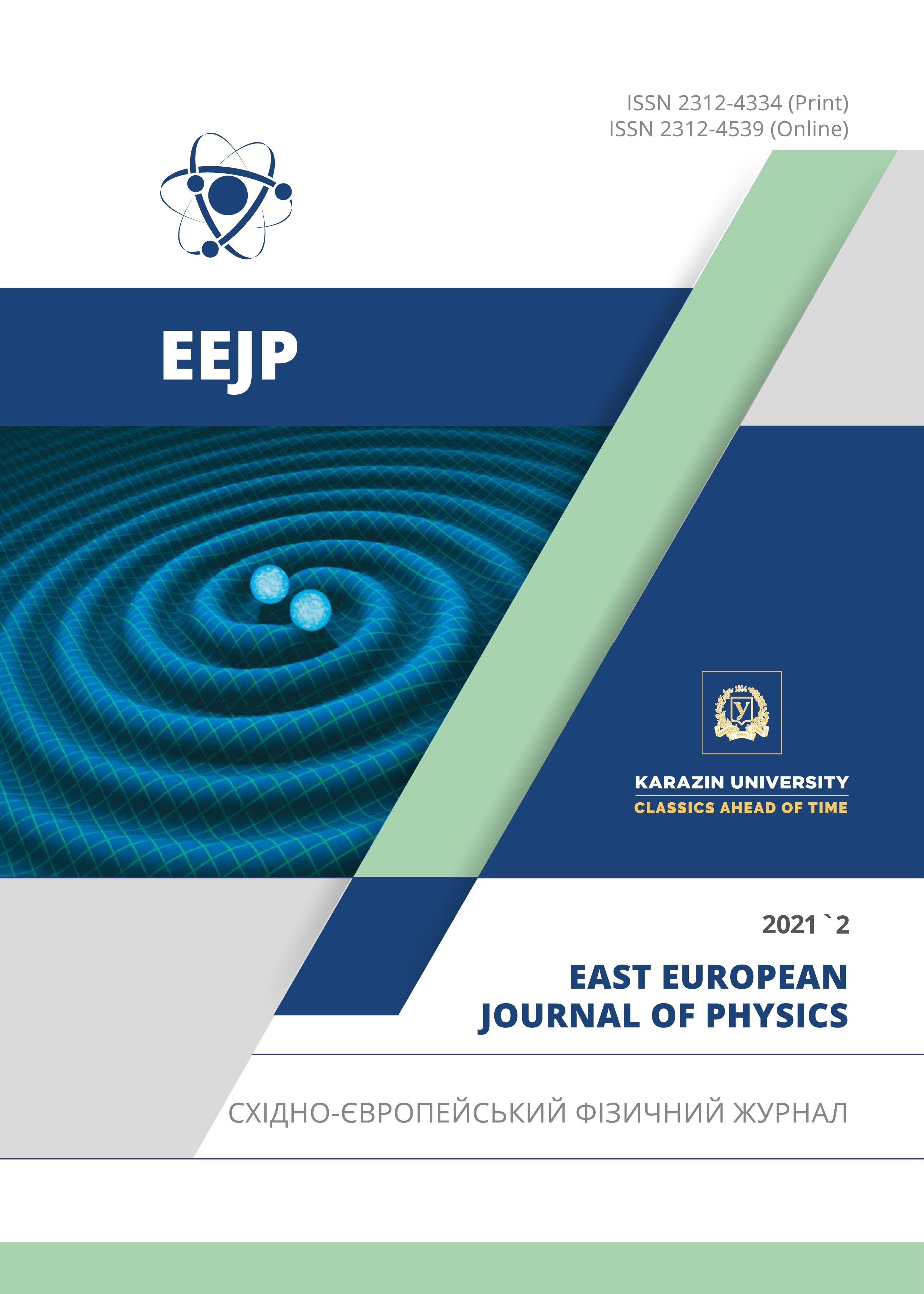Numerical Modeling and Analysis of HTM-Free Heterojunction Solar Cell Using SCAPS-1D
Abstract
In this research paper, a HTM-free perovskite solar cell (PSC) structure with Titanium (TiO2), methyl ammonium lead triiodide (CH3NH3PbI3) and platinum (pt) as electron transport material (ETM), photon harvester and metal back contact is proposed. Solar Cell Capacitance Simulator (SCAPS-1D) program was used to implement the model and simulation. Effect of parameters such as thickness of ETM, thickness of absorber, doping concentration of ETM & absorber and electron affinity (EA) of ETM were investigated systematically. From the obtained results, it was found that the parameters affect the performance of the solar cell. When the thickness of ETM was varied from 0.02 to 0.10 μm. The results show that photovoltaic parameters decrease with the thickness increase. When the thickness of the absorber was varied from 0.1 to 1.0 μm, the optimized value was found at thickness of 0.4 . When the doping concentration of absorber and EMT were varied from 1010–1017 cm-3 and from 1015–1020 cm-3, the highest values of PCEs were obtained at 1016 cm-3 and 1020 cm-3 for Absorber and ETM. Also when the EA was varied in the range of 3.7 eV to 4.5 eV, the optimized value was at 3.7 eV. Upon optimization of the above mentioned parameters, power conversion efficiency (PCE) was found to be 25.75 %, short circuit current density (Jsc) 23.25 mAcm-2, open circuit voltage (Voc) 1.24 V and fill factor (FF) 89.50 %. The optimized result shows an improvement of ~1.95 times in PCE, ~1.06 times in Jsc, ~1.44 times in Voc and ~1.28 times in FF as compared to the initial device with the following parameters, PCE=13.22 %, Jsc=21.96 mAcm−2, Voc=0.86 V and FF=69.94 %.
Downloads
References
J.S. Manser, and P.V. Kamat, Nature Photonics, 8, 737–747 (2014), https://doi.org/10.1038/nphoton.2014.171.
H. Chen, F. Ye, W. Tang, J. He, M. Yin, Y. Wang, F. Xie, E. Bi, X. Yang, and M. Gratzel, L. Han, Nature, 550, 92–95 (2017), https://doi.org/10.1038/nature23877.
G. Xing, N. Mathews, S. Sun, S.S. Lim, Y. M. Lam, M. Gratzel, S. Mhaisalkar, and T.C. Sum, Science, 342, 344–347 (2013), https://doi.org/10.1126/science.1243167.
M. Liu, M. B. Johnston, and H. J. Snaith, Nature, 501, 395–398 (2013), https://doi.org/10.1038/nature12509.
Z. Wang, Q. Lin, F.P. Chmiel, N. Sakai, L.M. Herz, and H.J. Snaith, Nature Energy, 2, 17135 (2017), https://doi.org/10.1038/nenergy.2017.135.
Y. Liu, Z. Yang, D. Cui, X. Ren, J. Sun, X. Liu, J. Zhang, Q. Wei, H. Fan, F. Yu, X. Zhang, C. Zhao, and S. Liu, Advanced Materials, 27, 5176–5183 (2015), https://doi.org/10.1002/adma.201502597.
D. Yang, Z. Yang, W. Qin, Y. Zhang, S. Liu, and C. Li, Journal of Materials Chemistry A, 3, 9401–9405 (2015), https://doi.org/10.1039/C5TA01824B.
A. Kojima, K. Teshima, Y. Shirai, and T. Miyasaka, Journal of the American Chemical society, 131(17), 6050-6051 (2009), https://doi.org/10.1021/ja809598r.
D. Eli, M. Y. Onimisi, S. Garba, and J. Tasiu, SN Applied Sciences, 2, 1769 (2020), https://doi.org/10.1007/s42452-020-03597-y.
N. Rajamanickam, S. Kumari, V. K. Vendra, B. W. Lavery, J. Spurgeon, T. Druffel, and M.K. Sunkara, Nanotechnology, 27, 235404 (2016), https://doi.org/10.1088/0957-4484/27/23/235404.
K.G. Lim, H.B. Kim, J. Jeong, H. Kim, J.Y. Kim, and T.W. Lee, Advanced Materials, 26, 6461–6466 (2014), https://doi.org/10.1002/adma.201401775.
D. Wang, M. Wright, N.K. Elumalai, and A. Uddin, Solar Energy Materials and Solar Cells, 147, 255–275 (2016), https://doi.org/10.1016/j.solmat.2015.12.025.
L. Etgar, P. Gao, Z. Xue, Q. Peng, A.K. Chandiran, B. Liu, M.K. Nazeeruddin, and M. Gratzel, Journal of the American Chemical Society, 134, 17396-17399 (2012), https://doi.org/10.1021/ja307789s.
Z. Li, S.A. Kulkarni, P.P. Boix, E. Shi, A. Cao, K. Fu, S.K. Batabyal, J. Zhang, Q. Xiong, L.H. Wong, N. Mathews, and S.G. Mhaisalkar, ACS nano, 8, 7, 6797-6804 (2014), https://doi.org/10.1021/nn501096h.
X. Zhang, Y. Zhou, Y. Li, J. Sun, X. Lu, X. Gao, J. Gao, L. Shui, S. Wu, and J-M. Liu, Journal of materials chemistry C, 7, 3852 3861 (2019), https://doi.org/10.1039/C9TC00374F.
L. Lin, L. Jiang, Y. Qiu, and Y. Yu, Superlattices and Microstructures, 104, 167-177 (2017), https://doi.org/10.1016/j.spmi.2017.02.028.
T. Wang, J. Chen, G. Wu, and M. Li, Science China Materials, 59(9), 703-709 (2016), https://doi.org/10.1007/s40843-016-5108-4.
Haynes, W (Ed), CRC handbook of chemistry and physics, 97th ed. (CRC press, New York, 2017).
S.Z. Haider, H. Anwar, and M. Wang, Semicond. Sci. Technol. 33(3), 035001 (2018), https://doi.org/10.1088/1361-6641/aaa596.
R Wei, M.Sc Degree Thesis, Queensland University of Technology, 2018.
U. Mandadapu, S.V. Vedanayakam, and K. Thyagarajan, Indian Journal of Science Technology, 10(11), 1-8 (2017), https://www.researchgate.net/profile/Victor-Vedanayakam-2/publication/316484058_Simulation_and_Analysis_of_Lead_based_Perovskite_Solar_Cell_using_SCAPS-1D/links/5a8afb1caca272017e639098/Simulation-and-Analysis-of-Lead-based-Perovskite-Solar-Cell-using-SCAPS-1D.pdf.
M. Amalina, and M. Rusop, World Journal of Engineering, 9, 251-256 (2012), https://doi.org/10.1260/1708-5284.9.3.251.
D. Eli, M. Y. Onimisi, S. Garba, R. U. Ugbe, J. A. Owolabi, O. O. Ige, G. J. Ibeh, and A. O. Muhammed, Journal of the Nigerian Society of Physical Sciences, 1, 72-81, (2019), https://doi.org/10.46481/jnsps.2019.13.
M. I. Hossain, F. H. Alharbi, and N. Tabet, Solar Energy, 120, 370-380 (2015), https://doi.org/10.1016/j.solener.2015.07.040.
L, Lin, L, Jiang, Y, Qiu, and Y. Yu, Superlattices and Microstructures, 104, 167-177 (2017), https://doi.org/10.1016/j.spmi.2017.02.028.
P. Gao, M. Gratzel, and M. K. Nazeeruddin, Energy and Environmental Science, 7, 2448-2463 (2014), https://doi.org/10.1039/C4EE00942H.
U. Mandadapu, S.V. Vedanayakam, and K. Thyagarajan, Int. J. Eng. Sci. Invention, 2,40-45 (2017).
W. Liu, and Y. Zhang, Journal of materials chemistry A, 2, 10244-10249 (2014), https://doi.org/10.1039/C4TA01219D.
Authors who publish with this journal agree to the following terms:
- Authors retain copyright and grant the journal right of first publication with the work simultaneously licensed under a Creative Commons Attribution License that allows others to share the work with an acknowledgment of the work's authorship and initial publication in this journal.
- Authors are able to enter into separate, additional contractual arrangements for the non-exclusive distribution of the journal's published version of the work (e.g., post it to an institutional repository or publish it in a book), with an acknowledgment of its initial publication in this journal.
- Authors are permitted and encouraged to post their work online (e.g., in institutional repositories or on their website) prior to and during the submission process, as it can lead to productive exchanges, as well as earlier and greater citation of published work (See The Effect of Open Access).








